Can Self-Watering Indoor Gardens Save You Effort and Money? We Tested 3 Systems
The initial cost is steep, but they're great for novice gardeners and experienced pros alike.
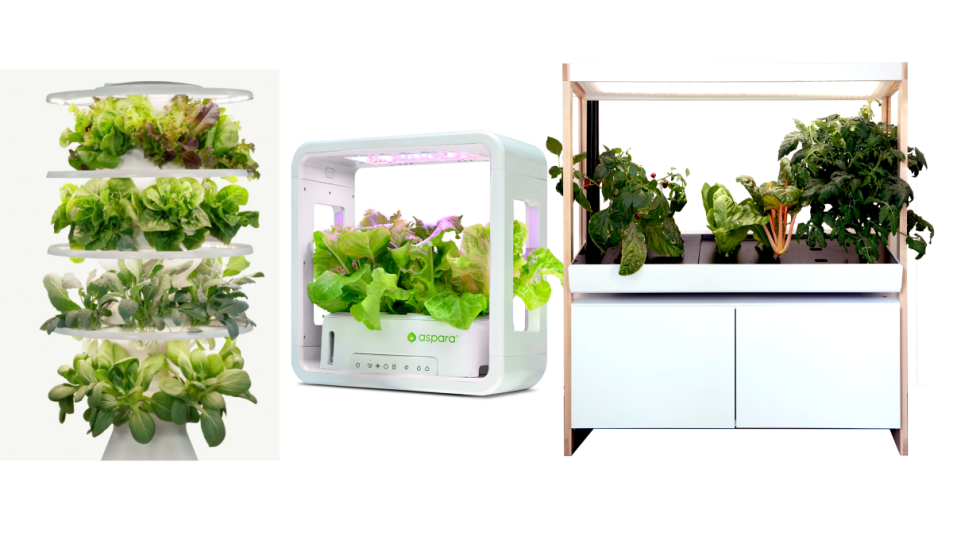
Confession: I don’t have much of a green thumb. I’ve always wanted to be the type of woman who could sense exactly how much sunlight and water her plants need — her vegetables weigh heavy on stems, her flowers always bloom in spring. But in reality, any greenery I’ve ever owned seems to wilt when I walk into the room (I give new meaning to a “withering look”). So, when I heard about the hydroponic garden — an indoor gardening system that uses no soil, and lights and waters itself — my eyes lit up. Here was a way to grow my own vegetables in the winter with half the effort. But would it be cost effective?
The First for Women team and I decided to put it to the test. We compared three different brands and determined the best features of each one. Here’s what we discovered: An indoor hydroponic garden is a wonderful way to bring your hobby indoors during winter and have fresh produce all year round. However, each system comes with a hefty price tag, and it’s hard to imagine that it will save you money on groceries. Still, it’s a room brightener, conversation starter, and exciting project to embark on.
We tested out three hydroponic systems: the Rise Garden, the Lettuce Grow Farmstand, and the Grow Green Aspara Stylist Lite. All three systems are very different from one another in terms of style, size, and what can grow, but they share a few pros and cons.
The Ups and Downs of an Indoor Hydroponic Garden
For anyone who doesn’t have a yard or the time to devote to a garden, hydroponics could be life changing. It creates reliability, because your plants will always be in a comfortable temperature with the right amount of light, water, and nutrients. Other benefits:
- No harmful pesticides. You know exactly what goes into your plants.
- Cut down on veggie prep. Since you’re growing your own lettuce, fruit, and vegetables inside, you don’t have to worry about deeply cleaning them before you eat. A simple rinse will do.
- Faster growth. Hydroponic plants grow faster than soil-based plants because the growing conditions are so consistent. So, you won’t have to wait too long to make a delicious salad.
- No strenuous gardening. Maintenance for most hydroponic systems takes as little as five minutes each week.
- You don’t need a green thumb. Most systems sold online take care of everything, down to the exact time your artificial lights turn off.
As with any household project, indoor self-watering gardens have some downsides, too:
- Price. There’s no getting around it; these systems are expensive. (At least they will last you for years.) In addition to the initial cost, you must pay for nutrients each month, seed pods or plants, water, and electricity. For smaller systems, water and electricity costs will be minor.
- Set-up. Big hydroponic systems mean more plants, but they also mean difficult assembly. Set-up for two systems we tried (Rise Garden and Lettuce Grow) took roughly 45 minutes each. You can speed things up if a second person helps you and you use a hose to fill the tank. But if your system is indoors and far away from a water source, you must use a sink and a pitcher.
- Mold and algae. Across all three systems, I struggled to keep algae and mold at bay. (This might have been caused by the conditions in my home, but in general, indoor hydroponic plants are more susceptible.)
- Cleaning. Most brands recommend doing a deep clean every three to four months. It involves taking out all the plants, dismantling certain parts, and scrubbing everything down, even the little plastic plant holders. A deep clean keeps your plants healthy and your system running smoothly, and it doesn’t have to happen that often. Still, it might be a deterrent.

Rise Gardens: Family Garden
- Description
- Pros
The Rise Gardens system is a self-watering, raised garden bed that uses no soil — only artificial light, water, and liquid nutrients. The classic tray style feels elegant and simple, and it will fit in with most home decor.
This hydroponic garden comes in four sizes (seeds and nutrients are included in the price):
- Personal: Holds eight plants ($279, purchase one 12-pod tray lid for an additional $19.99 to increase this to 12 plants)
- Single Family: Holds 12 plants ($679, purchase three 12-pod tray lids to increase to 36 plants)
- Double Family: Holds 24 plants ($879, purchase six 12-pod lids to increase to 48 plants)
- Triple Family: Holds 48 plants ($1,079, purchase nine 12-pod lids to increase to 106 plants)
- Cost includes seeds and nutrients
- Control lights from phone app
- Storage space for supplies
- Uses only 5 gallons of water
Rise Garden Pros
Easy maintenance. After set up, maintaining this single-family system has been straightforward and simple. I love that this hydroponic garden has bluetooth and connects to an app, so I can check the water levels and change the light schedule directly from my phone. (You can even connect the system to your Amazon Echo device and ask, “Alexa, how is my Rise Garden doing?”) Plus, the app sends me notifications when I need to add nutrients or water, and it tells me exactly how much nutrient I need to add. All of this means the guess work is taken out of gardening, so I don’t have to wonder if I’m doing it right. Weekly maintenance is about five minutes (easy peasy).
Seeds and nutrients included. The single-family garden that I received came with 14 seed pods and enough hydroponic nutrients for one month. I appreciated that these were included in the total cost. In addition, I like just how many plants this system can accommodate. Unlike some brands, a Rise Garden can grow greens, herbs, tomatoes, microgreens, vining crops, and rooted veggies at the same time in the same system.
Watch your plants grow from seeds. There was nothing like seeing my little seeds sprout for the first time. Even though the hydroponic system did all the work, I couldn’t help but feel like an excited, proud plant mama. Transferring the seedlings from the nursery to the actual watering tray was a big moment too — they had graduated. In about three weeks, I was ready to start harvesting some herbs, including cilantro and basil. My salad plants (Parris Island cos, Iceberg, and Buttercrunch lettuce) still need some time.
Sleek electronics. The electronics design is intelligent and high tech; the light wire fits snugly into a channel on one of the wooden supports so you don’t see it. Also, you need only one outlet (for one plug) to keep it running.
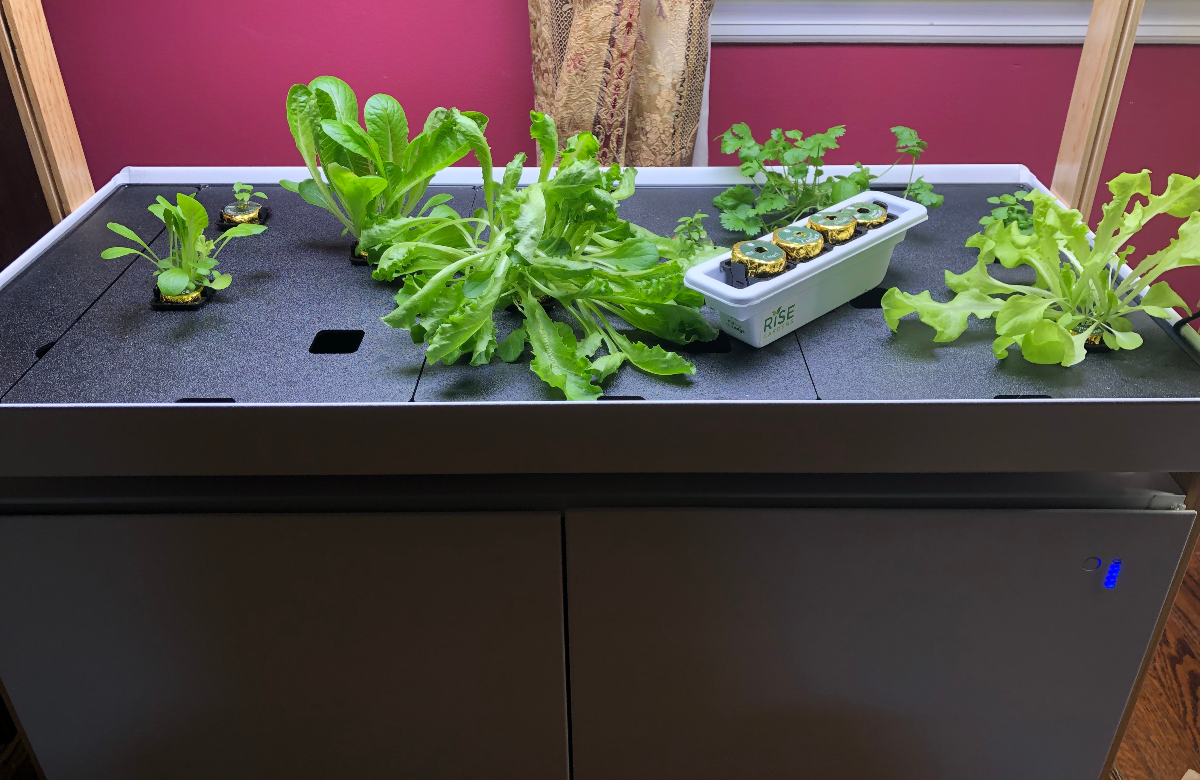
Rise Garden Cons
Setting up may be a challenge. Personally, I needed a family member to help me set up the Rise Garden. The instructions came in a helpful booklet and more information was available on their website, but I got confused at certain steps. Screwing in the wooden supports was also easier with two people. Filling the tank was a bit of a hassle (I used the pitcher they included) but not too bad, because it needed only five gallons. Overall, set up took about 45 minutes.
Deep cleans adds to maintenance. You need to complete a deep-clean of the system every three months, and it’s very involved (scrubbing down the water trays, unplugging the pump, carefully removing the five-gallon water tank and cleaning it). It’s a necessary step for any hydroponic garden — your pump can get clogged and plant matter buildup can harm your veggies. And the website walks you through it step by step, alleviating some of the difficulties. Still, it’s important to know what you’re getting into.

Lettuce Grow: The Farmstand
- Description
- Pros
The Farmstand from Lettuce Grow is unique, because most manufacturers don’t attempt a vertical hydroponic garden. It works well, too; the watering system uses a pump to pull water up from the tank and rain it down on the roots inside. This helps aerate the water, and it sounds like a gentle waterfall when it turns on (a surprising, relaxing perk).
The Farmstand comes in five sizes:
- 12 plants ($399, two levels that each fit six plants)
- 18 plants ($474, three levels)
- 24 plants ($549, four levels)
- 30 plants ($624, five levels)
- 36 plants ($699, six levels)
- Elegant style with a small footprint
- Plants come pre-grown
- App tells you when to add water, nutrients, and harvest plants
- Outdoors or indoors
Lettuce Grow Pros
No screws or screwdrivers needed. When I first opened the box to my 24-plant Farmstand, I almost thought I was looking at futuristic spaceship parts. It looked big and daunting, which made me think it would take a long time to set up. Fortunately, it was simple to put together, and the video tutorial helped me tremendously. I needed no screwdrivers, because each level and each ring light twists and locks into place. In total, it took me about an hour to do, mainly because I filled the tank with a pitcher (more on that later).
The phone app and timers are life-changing. Though The Farmstand doesn’t have bluetooth, it does have a phone app, which offers helpful advice and a plant identifier. (If you forget what you planted, you can take a picture, and the app tells you what it is.) The system also has two timers — one for water, and one for light. Setting up the timers took me longer than I’d like to admit (those contraptions felt counter-intuitive). Still, they’re worth the initial effort, because you’ll never have to think about watering or lighting again.
Plants come as seedlings, not seeds. When my plants came, I greatly appreciated that they were pre-grown. This took the worry out of whether or not the seeds would sprout, and it cut down the growing time. They seemed a little stressed when I transferred them into the system, but with the water running every 45 minutes and the lights active, they perked up in no time. In just two weeks, my plant babies were growing so quickly that it was almost out of control — a big payoff for about five minutes of maintenance per week.
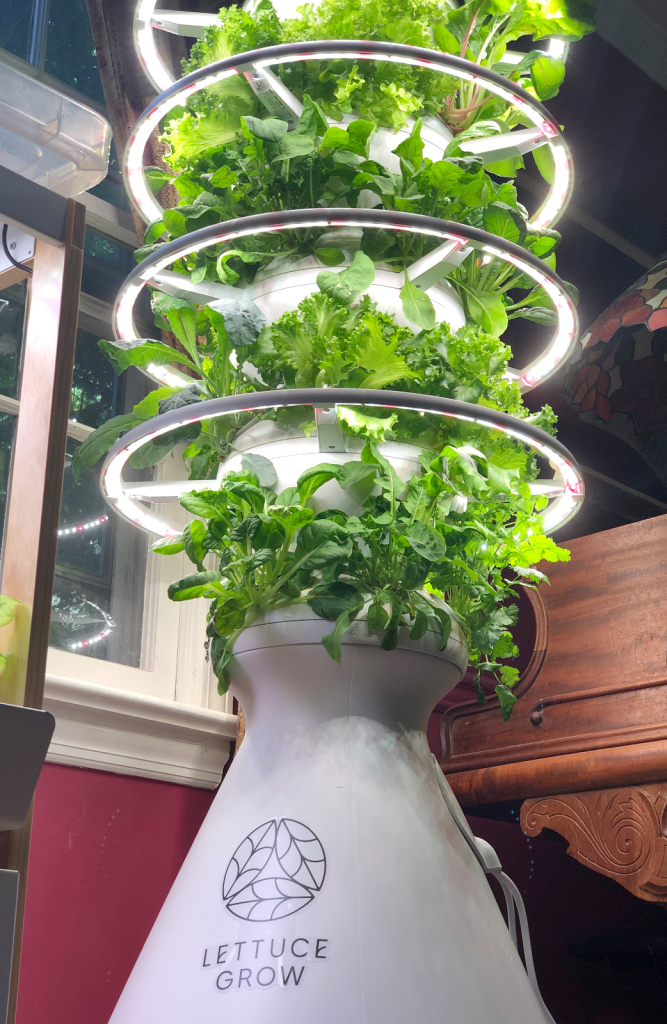
Functions well outdoors. First editor Alexandria Brooks also tested out the Farmstand, and said it’s an excellent product for a novice gardener. “The first three weeks were an adjustment period,” she told me. “I was getting used to checking the water’s pH levels and adding nutrients weekly. Luckily, the Lettuce Grow app is useful for setting reminders to alert me when it’s time to add nutrients and monitor the water’s pH. So, now I’m past those growing pains and have gotten into the groove of gardening. I’ve harvested mint, basil, Swiss chard, lettuce, thyme, and Tatsoi (a leafy green). I’m currently waiting for my cherry tomatoes, cucumbers, and zucchini to mature for harvesting in about a week or two.”
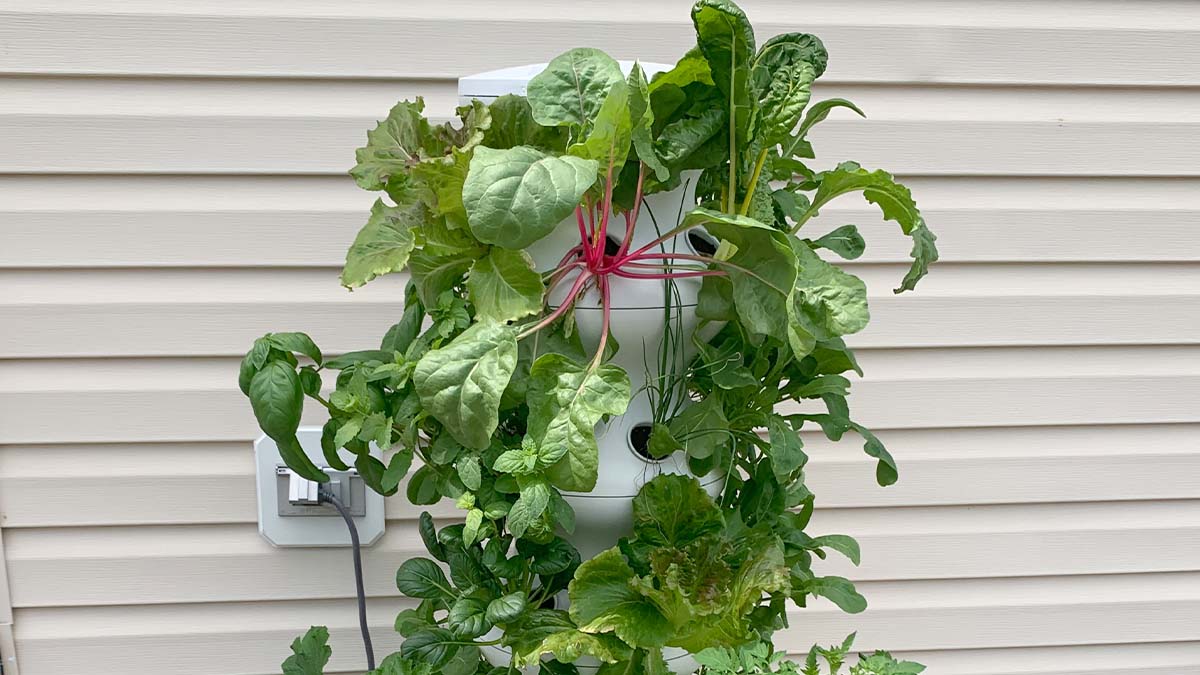
Lettuce Grow Cons
The tank needs a lot of water. As you might have guessed, filling the tank was difficult. It holds a whopping 20.5 gallons, so it took quite some time and effort to fill. It wasn’t easy to pour water into the tank hole on the side, either — I dribbled a lot. (I’m glad I followed their recommendation of placing a mat under the system to catch water.) The tank was clearly designed for a hose, but since I was setting it up indoors, the sink was all I had. In addition, thoroughly stirring in the initial eight scoops of nutrients was made difficult by the small tank hole and the pipe that runs through the tank’s center.
To be fair, Alexandria didn’t have any problems setting up her Farmstand outdoors. “Putting together the Farmstand and placing it in my patio wasn’t too much of a hassle,” she said. “I haven’t had any major problems with pests and insects, either, but I always keep insecticide handy just in case. All in all, I’d say that I’m a more confident grower thanks to this easy gardening system. It’s a new and fun experience each day.”
Glow rings sold separately. If you want to use your Farmstand indoors, you’ll have to purchase one glow ring per level ($100 each).
Seedlings sold separately. Seedlings cost $2.50 each, with free shipping included on 12 or more plants.
A final note: Ultimately, I too fell in love with this system. The design is beautiful, and the plants grow big and lush in no time. I found subsequent Lettuce Grow videos and articles extremely helpful, and learned a great deal about plants and hydroponics in general.

Grow Green: Aspara Stylist Lite
- Description
- Pros
The first thing you’ll notice about the Aspara Lite is its size. It takes up very little counter space, and it holds just eight plants at a time. This might be a downside for those who want a steady supply of produce year-round. For others, the trade off of a simple system with few cleaning requirements might be worth it.
Grow Green sells three versions of the Smart Grower (cost of two seed kits included):
- Aspara Nature ($279, with an automatic watering system)
- Aspara Stylist Lite ($179, with a simple water reservoir and pump)
- Aspara Stylist Lite, Art Series ($189, same as the Stylist Lite but with a colorful, kid-friendly decoration)
- Least expensive for its size
- Cost includes 2 seed kits
- Transportable
- Water tank is easy to clean
Aspara Pros
Easy set-up. After setting up two big hydroponic gardens, I enjoyed the Aspara’s quick set up. The instructions were simple and straightforward, and everything came together in about 10 minutes. Once the seed kits were delivered, I placed each seed pod in the included plant nursery (a black tray) and let them sit, covered, for about five days. By that time, the plants had sprouted. I added water to the reservoir, which took only about half a pitcher, sprinkled in the nutrient powder, and transferred my eight Romaine lettuce sprouts to the Aspara. Overall, this process was the simplest of the three systems and felt very user-friendly. (This makes sense, because the Aspara Lite is marketed as a way of teaching children about hydroponics. If you buy it, try making it a fun activity for kids or grandkids.)
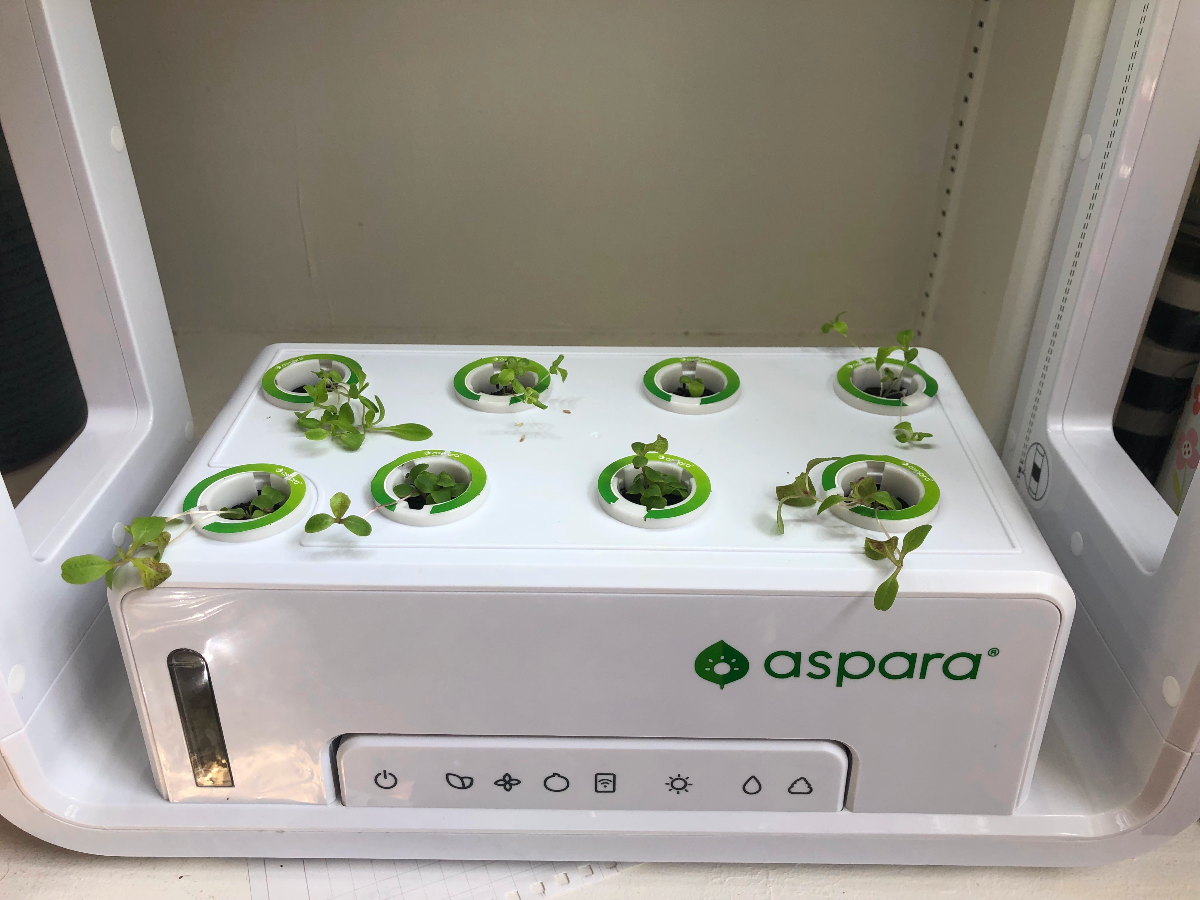
Lights and water pump are built-in. I also like that the light systems and other automatic settings (like the water pump) are all built into the system. However, growth on these plants has been rather slow, so I may need to add more nutrients or find a setting that turns on the water pump more frequently. (The pump adds oxygen to the water, which hastens growth.)
Aspara Cons
Needs better instructions. Though the Aspara Lite was the easiest to get going, the instructions were somewhat unclear. Neither the phone app nor the website offered tips specific to the Aspara Lite. (How much nutrient was I supposed to add to the water? I couldn’t find the answer.) I managed to piece together what I needed to do for the seeds, but online guidelines and an updated FAQ section would be helpful.
Less plant variety. Another downside: Unlike other brands, you can’t mix and match the seeds that come in your seed kits, and there aren’t as many options. The seeds are supplied in set packs, such as: Romaine, Butterhead lettuce, cherry tomato, or herb mix. (I received Romaine and an herb mix, which I have yet to try.)
Hopefully, this guide helps you make the right decision when it comes to purchasing a hydroponic gardening system. As for me, I’m just about ready to harvest more veggies. Swiss chard, anyone?
















